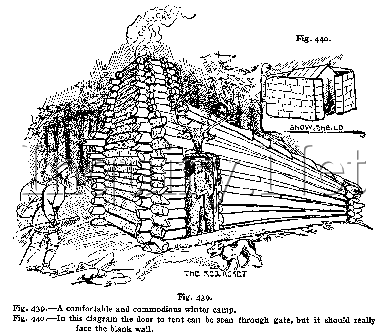The Brunswick and the Northwood
these well-known camps previously depicted and described are both open-faced shacks with the opening protected by a log-fenced fireplace, or one with a green hemlock fire shield, but in both cases the snow and wind are but slightly impeded from entering the camp, and if a Dixie is substituted for the uncovered fire, as is the case with

The Red Jacket,
shown by Fig. 439, a much more comfortable and cozy winter camp is secured, with but little additional work. A tent is all the protection many sportsmen and explorers require, even when camping in the extreme north, and a tent can be made very comfortable by surrounding it with a wind and weather shield, built of snow in the form of a wall, as in Fig. 440. In this way the whaler's ships, frozen in the Arctic Ocean, are walled in to keep the interior of the vessels warm during the long winter months.
But the city man who camps in winter for a short holiday in the woods may not find sufficient snow for this purpose, or may not find it too wet to be used in this manner. Such a man may even prefer to go without a tent and depend upon the material the forest furnishes to supply him with shelter farm sleet and cold is winds. In this case a light, easily constructed camp may built on the plan of the
But when one expects to spend the whole winter in the woods, the ideal camp is a small, but regular built
Log House,
with side walls about 4 feet high, roof tree 6 1/2 feet high. Make it a square structure with a Dixie fireplace and chimney, a bunk in one comer, racks on the walls for guns and traps, pegs for clothes, snowshoes, etc., and a warm welcome for the passing stranger. But all this is for big boys, so we will make the pages on snow houses and snowmen for the younger readers.